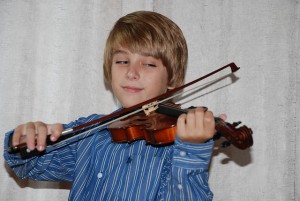
To start working with the idea of harmonic accompaniment to tunes or improvisation, I start with “Twinkle Twinkle” in A major. I make sure the student understands the A major scale and arpeggio set.
Next, I give them a simple accompaniment pattern and show how to put it in all keys. Here is an example. Then I also give them a chord chart. The part marked “guitar” contains all the first position notes the violin player can choose from for the pattern. Of course not even the guitar plays all the notes given. The letter names above the chords indicate the name of the chord as the guitar player uses it. The roman numerals below the chords indicate their relationship to the A Major scale.
The first pattern on the “Patterns and Keys” document gives the chord patterns beginning on the open strings, G, then move to D and repeat, move to A and repeat. The second pattern starts with the A major chord pattern beginning on the G string. That gets out of the range of the written “Twinkle”. I use this set up until the student can play the accompaniment to “Twinkle” guided by his/her ear. I like for them to be able to do that in D major and G major also. At that point we can try another tune.
